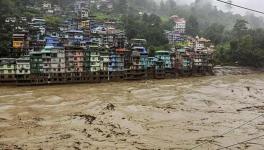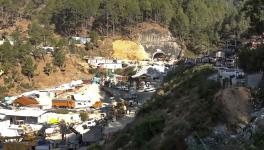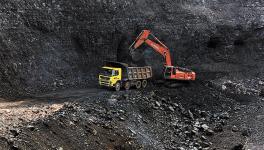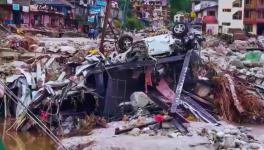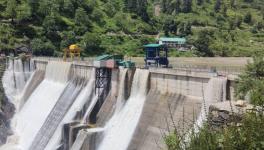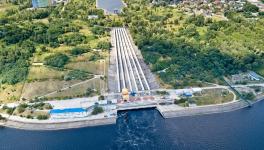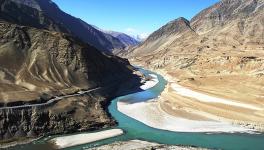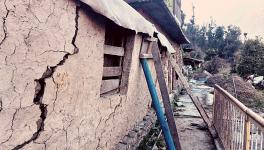We are Witnessing Malignant Growth, Dubbed by Govt as ‘Vikas’: Scientist SP Sati
NDRF and SDRF teams prepare for the demolition of the Hotel Malari Inn, which has been marked unsafe, in Chamoli district, Uttarakhand, Saturday, Jan. 14 , 2023. Image Courtesy: PTI
Leading geologist Dr SP Sati heads the Basic and Social Science department at the College of Forestry in the Veer Chandra Singh Garhwali Uttarakhand University of Horticulture and Forestry. In an interview with NewsClick, he says Uttarakhand’s governments ignored scientific warnings about heavy-construction-led environmental damage in Joshimath and the entire upper Himalayan region. It is this neglect, in which the National Thermal Power Corporation (NTPC) has a role too, for which the residents are paying the heaviest price today. Edited excerpts.
Rashme Sehgal: Why has Joshimath town been allowed to sink?
S P Sati: Joshimath is located in a highly seismic zone. Its subsidence problems got exacerbated with the construction of the tunnel for the Tapovan Vishnugad Hydropower Plant in 2006. Its population, many of whom have been forced to evacuate their unsafe homes, put the blame on the National Thermal Power Corporation (NTPC) for destroying both their homes and their source of livelihood.
RS: To what extent is construction of NTPC’s underground tunnel, part of the Tapovan Vishnugad hydropower project close to Joshimath, responsible for the present situation? Has any enquiry been conducted into the possible link?
SPS: On December 24, 2009, a tunnel boring machine (TBM) punctured an aquifer at a depth of around 900 metres, located in a fault zone. This happened near Selang village, 5 kilometres before Joshimath. It resulted in a massive discharge of high-pressure sub-surface water at around 700 litres per second—enough water to sustain 20-30 lakh people per day. The TBM got stuck in the rocks, and no attempt was made by the NTPC engineers working on this project to retrieve it.
Two similar trapping incidents of this magnitude took place [in which two other TBMs got stuck] in February and October 2012. The front and telescopic shields of the TBM were jammed in a wedge failure within the tunnel. These accidents also led to massive surges of high-pressure sub-surface water containing crushed material breaking to the surface. As far as I know, both subsequent jamming incidents went unreported.
Since the first accident, Joshimath residents had complained that groundwater springs in their area were all drying up and cracks had appeared in their houses. This was reported to the local authorities. The key question before us is what steps did NTPC take to stop the flow of water from the aquifer? As the water flow increased, so did water percolation. The cavity in the rocks simply grew larger.
RS: What steps would scientists have recommended NTPC take in such a situation?
SPS: As a first step, they should have done extensive grouting and replaced the segmental lining of the tunnel with a more robust lining. This was not done. Can you imagine the magnitude of the neglect? The NTPC engineers simply left the machines stuck in the tunnel and ran away. This information is not based on my report. A group of scientists from abroad made an enquiry, whose results have been published in scientific journals. I am repeating what they found.
Even worse, the tunnel was dug on a fault zone. A fault is where the rock has been fractured and begins to crumble. Was a physical survey of this entire area done before undertaking work on the tunnel? The NTPC should have anticipated such a situation. They did not. My understanding is that no such survey was done, which was sheer negligence on their part.
What safety measures did the NTPC institute before starting work on a fault line? Has responsibility been fixed? Did these officials not understand that when no attempt was made to stop the aquifer, the result would be increased water percolation, which can go in any direction? All this has resulted in major changes in hydraulic properties, particularly the increased permeability of the rock mass within several metres and probably within tens of metres of the tunnel walls. So, to therefore state, as the NTPC spokesperson has, that the tunnel is some distance from Joshimath, does not have any scientific basis. Because water can permeate in any direction. Tests need to be undertaken to find out just how much of this water did permeate and in which areas, especially since the water discharge from this tunnel has not stopped to this date.
RS: Are there other concerns in Joshimath compounding the problem?
SPS: I must highlight that muck-laden water has also been oozing into the city from the February 7, 2021 floods in the Rishiganga and Dhauliganga rivers that entered the Tapovan Vishnugad project’s under-construction tunnel. This ooze, too, has worsened the situation in Joshimath.
And, the Helang-Marwari bypass road, which falls under the Char Dham road expansion project, has also worsened the situation. Geologist Navin Juyal had asked the Uttarakhand government to conduct a geo-technical feasibility study before beginning work on the road, but they simply chose to ignore this suggestion. Explosives are being used to construct this bypass road, which has only served to weaken the mountain slopes further.
RS: We are often told that this is happening in a highly seismic zone—what is the exact nature of the risk from heavy construction?
SPS: It is in the highest risk zone, which is Zone 5. Joshimath town’s lower boundary is in the Main Central Thrust, and its upper boundary is in the Vaikrita Thrust. The town was built on a highly unstable foundation of loose glacial material that can give way in case of heavy rains or tremors. And subsidence has also been taking place because of unregulated construction far beyond the city’s carrying capacity, which compounds these problems. A central team of scientists are in Joshimath at present to survey the damage, but I was there in 2021 along with two other geologists, and we had warned of the emerging crisis. Our warnings went unheeded.
RS: What are the issues of concern regarding the construction of large hydro projects in the upper Himalayas?
SPS: Following the Kedarnath floods in 2013, which damaged 10 dams, I had issued a warning against the construction of dams in the upper Himalayas, which are a highly seismic zone and remain very vulnerable. Scientists around the world have been reiterating against construction of dams in the higher Himalayas.
The 2013 disaster saw the destruction of the dam constructed as part of the Vishnuprayag Hydro Electric Plant. The Tapovan Vishnugad project has also been damaged three times by flash floods. When work started on it, I warned the government that it would never be able to complete this project. The Dhauliganga is an uncontrollable river, impossible to tame.
What I am saying has been said repeatedly by several scientists before me. The MC Mishra committee had in 1976 recommended against the construction of large projects in this region. All these recommendations have been disregarded and what we are witnessing is malignant growth which the government dubs as ‘vikas’.
RS: The Centre has put together an investigating team. Do you have a role as an expert who has witnessed and studied problems with the construction of large projects?
SPS: Scientists who speak out against government policy seldom find a place in such committees. The government received repeated warnings about Joshimath and their destructive policies in the upper Himalayas. Scientists from the Wadia Institute of Himalayan Geology and the Supreme Court-appointed committee, headed by Dr Ravi Chopra, had issued warnings against both these power projects and indiscriminate construction. All these have gone unheeded.
Get the latest reports & analysis with people's perspective on Protests, movements & deep analytical videos, discussions of the current affairs in your Telegram app. Subscribe to NewsClick's Telegram channel & get Real-Time updates on stories, as they get published on our website.









